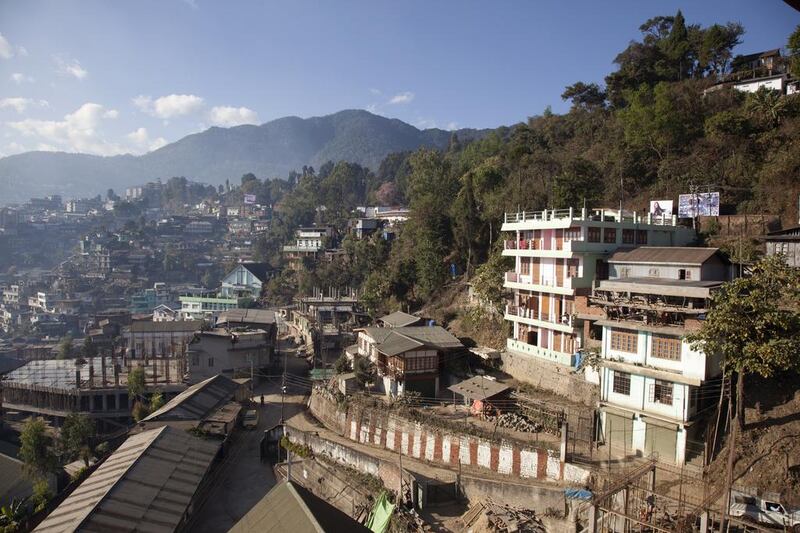Why Kohima?
The capital of the far north-eastern state of Nagaland is on a mountain ridge, and remains largely off the radar of tourists. Torn by insurgency for many decades, it’s finally enjoying peace after an accord signed last year by the government and tribal groups. Nagaland is a biodiversity hotspot, with a wealth of birdlife, flowers and trees, and the Intanki Wildlife Sanctuary, home to the rare hoolock gibbon.
Most travellers to India are yet to discover the area, with its backdrop of mist-enshrouded mountains, vast swaths of paddy fields and rivers. It’s home to the Hornbill Festival, held each December at Kisama Village. The festival gives a unique opportunity to enjoy the incredible diversity of 16 tribes in one place. Kohima is also attractive to hikers, with the second-highest peak in the state, Mount Japfu, at 3,048 metres. It’s also home to a vibrant music scene – rock ‘n’ roll and Naga pop.
A comfortable bed
The new Kohima Camp, Nagaland (www.kohimacampnagaland.com) pitches luxury tents in the middle of a forest, at the foot of Mount Japfu, complete with butlers and other mod cons. With solar-powered tents, beds draped with mosquito nets, leather chairs, cupboards and even a study, it's "glamping" at its best. The camp offers two-, three-, four- and five-night itineraries, costing from 116,000 rupees (Dh6,304) per person, on a twin-sharing basis, including transfers from Dimapur, meals and excursions.
The Hotel Orchid (Chandmari Road, Midland) is a boutique hotel with 14 rooms, plus a restaurant offering Naga delicacies. Double rooms cost from 4,500 rupees (Dh245) per night).
Another option is Hotel Japfu (www.thenagalandhotels.com), which has comfortable doubles with hill views from 3,000 rupees (Dh163) per night.
Find your feet
A convenient way to get your bearings and take in all the city's sights is a visit to the Kohima War Cemetery (www.cwgc.org), designed by Sir Edwin Lutyens, the architect of colonial Delhi. It was here in April 1944 that a small force of British soldiers was surrounded by 12,000 Japanese troops trying to reach Delhi and take over India. The cemetery has a great panoramic view of the city.
From here, make your way to Kohima Zoo. Drive to Kisama Heritage Village, 12 kilometres from the capital, which is an open-air museum and the venue for the Hornbill Festival. It gives a window into tribal culture, with traditional Naga long houses called morungs. There’s no public transport, so hire a tourist taxi to take you around.
Meet the locals
The Naga Market is where you will find locals buying their groceries – buckets of snails, honeycomb, borol (a delicacy of hornet grubs), tadpoles in plastic bags, wild mushrooms, banana flowers, forest ferns, beans and lentils, fermented tofu and beef, and hellishly hot Raja Mirch chillies. Also head to the thriving night market in downtown Kohima, where local bands perform, grilled meats are sold, and local families with children enjoy the kitschy atmosphere with masks and balloons.
Book a table
For a taste of authentic Naga food – a carnivore’s dream that also uses flavourings such as bamboo shoots, yams and fermented soy – head to Orami (near NSF Martyrs’ Park). Tastefully done up with tree trunks and branches painted silver, earthen pots and tribal paintings, it also serves a complimentary tea made from a local wild berry. A meal for two costs about 750 rupees (Dh41).
Ozone Café (Imphal Road) serves great coffee, and is one of the best places in Kohima for fried momos.
Shopper’s paradise
Kohima is known for indigenous crafts such as shawl weaving and basketmaking. The Bamboo Pavilion in Kisama Heritage Village is the best for bargains and a taste of traditional shopping. Look out for bamboo baskets, beaded and bone jewellery.
A must-buy are bright woollen Nagashawls. Each tribe has a distinctive design – the Angami use red and yellow bands on a black background, while the Ao warrior shawls have elephant or tiger motifs. Try the Nagaland Emporium (opposite the bus station) for handwoven bedcovers, cushions covers, etc.
Western Book Depot (Main Road), set up in 1983, is the oldest bookstore in Kohima, and is a good place for books by Naga writers and historians.
Don’t miss
The three-floor Kohima State Museum (near the bus station) is a must for all tourists. It houses rare artefacts belonging to different tribes of the state. Colourful traditional dresses, weaponry, clan motifs, tableaus with mannequins and even “hunted” human skulls are displayed. Don’t miss the ceremonial drum, which is similar to a canoe and struck with huge oar-like poles.
What to avoid
Kohima’s pleasant climate allows year-round tourism, though it’s best to avoid the wet monsoon season (June to September).
Getting there
Etihad (www.etihad.com) flies from Abu Dhabi to Kolkata from Dh1,760, including taxes. Indigo (www.goindigo.in) flies from Kolkata to Dimapur, Nagaland's only airport, from 8,000 rupees (Dh435) return, including taxes, then it's a three-hour drive from Dimapur to Kohima.
travel@thenational.ae
Follow us @TravelNational
Follow us on Facebook for discussions, entertainment, reviews, wellness and news.





